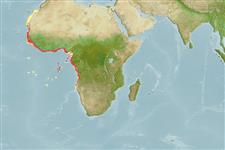Teleostei (teleosts) >
Gadiformes (Cods) >
Merlucciidae (Merluccid hakes)
Etymology: Merluccius: Latin, mar, maris = the sea + Latin, lucius = pike (Ref. 45335).
Eponymy: Dr Max Fernand Leon Poll (1908–1991) was a Belgian ichthyologist, and ‘connoisseur of the fish fauna’. [...] (Ref. 128868), visit book page.
Environment: milieu / climate zone / depth range / distribution range
Ecology
Marine; bathydemersal; non-migratory; depth range 50 - 1248 m (Ref. 112558), usually 50 - 550 m (Ref. 58452). Deep-water; 29°N - 19°S, 19°W - 15°E (Ref. 58452)
Eastern Atlantic: off the coast of tropical West Africa, from Mauritania to Angola. Range reported to extend to off southwest Africa near Cape Frio, Namibia (Ref. 6524).
Length at first maturity / Size / Weight / Age
Maturity: Lm 44.4 range ? - ? cm
Max length : 80.0 cm TL male/unsexed; (Ref. 1371); common length : 40.0 cm TL male/unsexed; (Ref. 26999)
Dorsal spines (total): 1; Dorsal soft rays (total): 45 - 52. Head large and little depressed. Pectoral fin tips usually reaching the origin of anal fin in small but not in large individuals. Scales easily shed. Color usually blackish on back, steel gray to blackish on belly; caudal fin white-edged.
Feeds mainly on small fishes and partly on squids and shrimps (Ref. 1371). Marketed mostly fresh and frozen, also used for fishmeal and oil (Ref. 1371). Minimum depth reported taken from Ref. 1371.
Life cycle and mating behavior
Maturity | Reproduction | Spawning | Eggs | Fecundity | Larvae
Cohen, D.M., T. Inada, T. Iwamoto and N. Scialabba, 1990. FAO species catalogue. Vol. 10. Gadiform fishes of the world (Order Gadiformes). An annotated and illustrated catalogue of cods, hakes, grenadiers and other gadiform fishes known to date. FAO Fish. Synop. 125(10). Rome: FAO. 442 p. (Ref. 1371)
IUCN Red List Status (Ref. 130435: Version 2024-2)
Threat to humans
Harmless
Human uses
Fisheries: minor commercial
Tools
Special reports
Download XML
Internet sources
Estimates based on models
Preferred temperature (Ref.
123201): 7.3 - 19.8, mean 14.2 °C (based on 93 cells).
Phylogenetic diversity index (Ref.
82804): PD
50 = 0.5000 [Uniqueness, from 0.5 = low to 2.0 = high].
Bayesian length-weight: a=0.00437 (0.00237 - 0.00803), b=3.10 (2.94 - 3.26), in cm total length, based on LWR estimates for this Genus-body shape (Ref.
93245).
Trophic level (Ref.
69278): 4.5 ±0.63 se; based on food items.
Generation time: 2.8 ( na - na) years. Estimated as median ln(3)/K based on 1
growth studies.
Resilience (Ref.
120179): Medium, minimum population doubling time 1.4 - 4.4 years (K=0.39(?); assuming tm>=2).
Fishing Vulnerability (Ref.
59153): Low to moderate vulnerability (35 of 100).
Climate Vulnerability (Ref.
125649): High vulnerability (58 of 100).
Nutrients (Ref.
124155): Calcium = 11.3 [5.5, 40.8] mg/100g; Iron = 0.351 [0.069, 0.938] mg/100g; Protein = 17.3 [16.0, 18.5] %; Omega3 = 0.158 [0.081, 0.306] g/100g; Selenium = 28.7 [12.1, 62.7] μg/100g; VitaminA = 9.7 [1.9, 42.7] μg/100g; Zinc = 0.203 [0.137, 0.312] mg/100g (wet weight);
